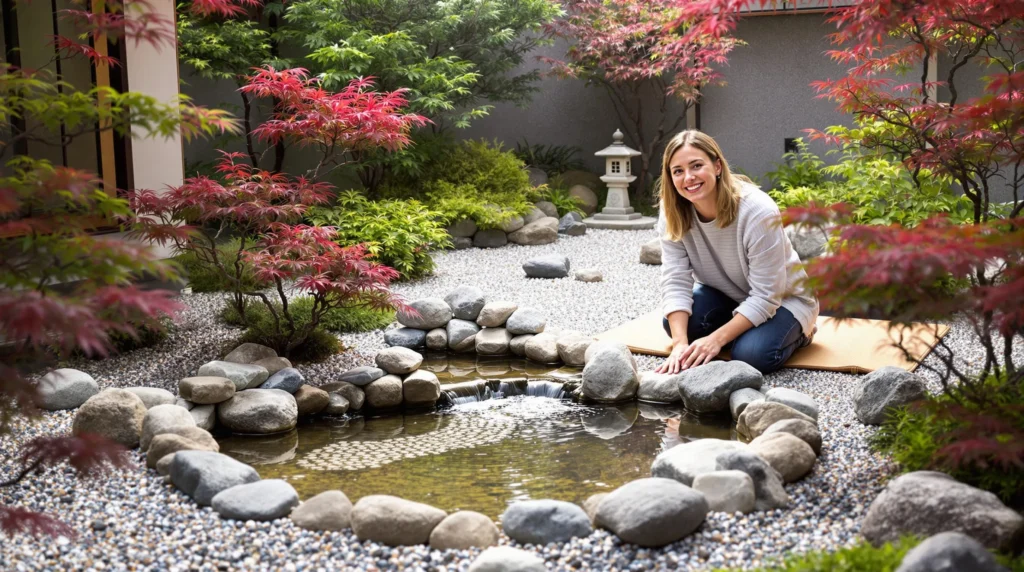Creating Zen-Inspired Rock Gardens for Limited Spaces
Rock gardens (karesansui) are perfect for small Japanese gardens, representing larger landscapes in miniature form. These zen-inspired spaces create a meditative atmosphere while requiring minimal maintenance and space.
Selecting the Right Stones for Your Miniature Karesansui
Choose 3-5 weathered stones of varying heights and shapes for your miniature rock garden. Opt for naturally aged rocks with interesting textures and neutral colors like slate gray, charcoal, or sandstone beige. Position your largest stone as the focal point, representing a mountain or island, with smaller stones arranged asymmetrically to create visual tension. For authentic Japanese aesthetics, incorporate vertically oriented stones (tate-ishi), reclining stones (shintai-ishi), and flat stones (hirai-ishi) to symbolize different natural elements. Avoid perfectly round or uniformly colored stones as they lack the wabi-sabi imperfection central to Japanese garden philosophy.
Incorporating Sand and Gravel Patterns
Fine white gravel or crushed granite creates the foundation for your zen garden’s distinctive patterns. Rake the gravel in straight lines around rocks to represent flowing water, using a small wooden rake with evenly spaced tines for precision. Create concentric circles around individual stones to symbolize ripples, or carry out wave patterns that mimic ocean currents. In extremely small spaces, consider a desktop zen garden using a shallow wooden box filled with fine sand and miniature stones. Maintain your gravel patterns by regularly raking after rain or wind disturbance, which also serves as a meditative practice aligning with the garden’s contemplative purpose.
Incorporating Essential Water Features in Compact Areas
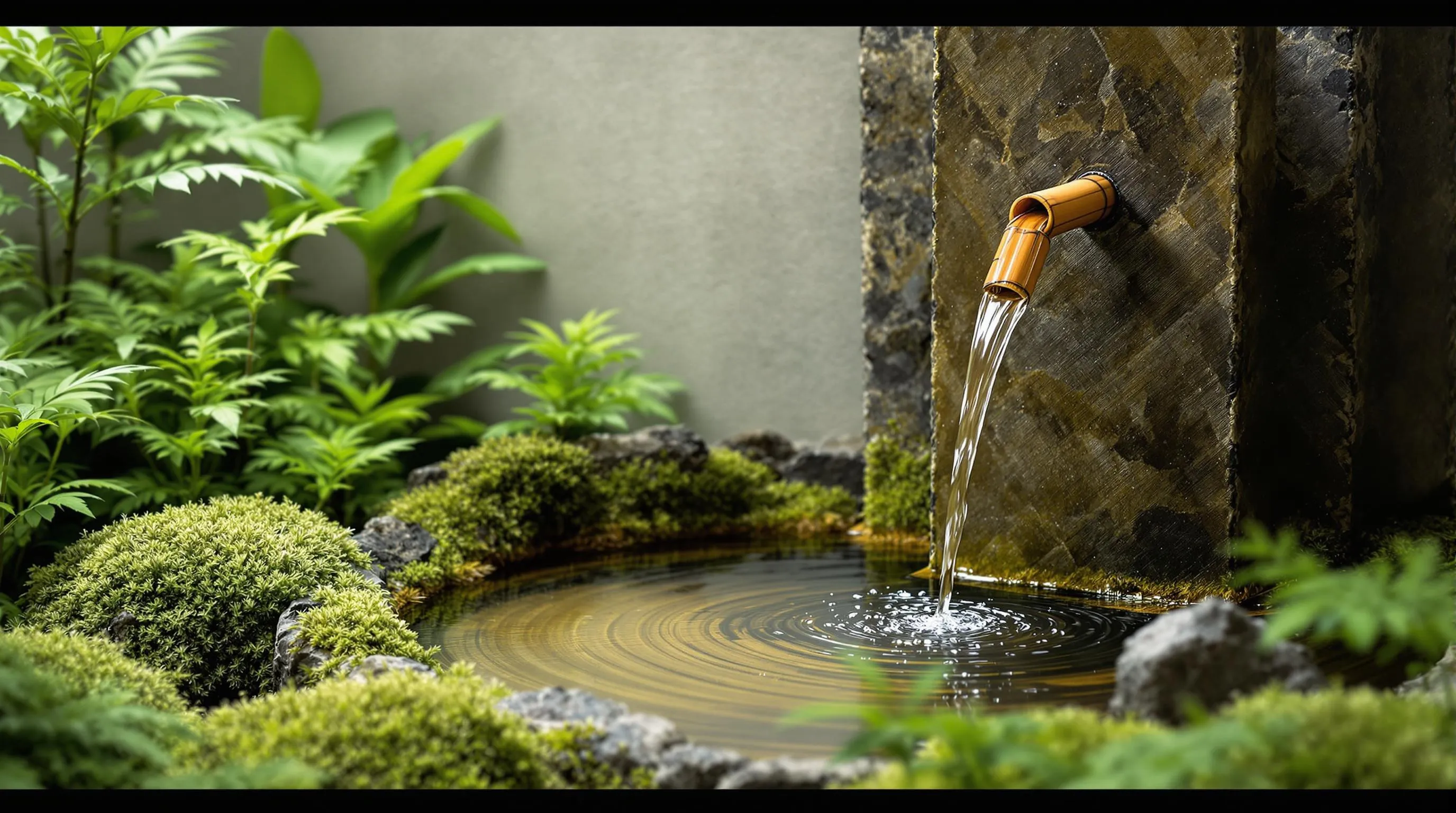
Water is a fundamental element in Japanese garden design, representing purity and the flow of life. Even in the smallest spaces, you can incorporate water features that capture the essence of traditional Japanese gardens without overwhelming your limited area.
Mini Tsukubai Water Basins
Mini tsukubai water basins offer a perfect solution for tiny Japanese gardens. These compact stone basins originally served as ritual washing stations at temple entrances but have evolved into decorative garden elements. You’ll find they require minimal space—just 2-3 square feet—while providing the soothing sound of water. Place your tsukubai in a partially shaded area and surround it with small moss patches or miniature ferns for an authentic look. For an even smaller footprint, consider ceramic versions that can be positioned on a deck or patio. The gentle water ripples create movement and attract birds, bringing life to your compact garden space.
Space-Saving Bamboo Fountains
Bamboo fountains serve as vertical water features that maximize limited garden space. These slender elements use bamboo spouts (shishi-odoshi) that fill with water before tipping to create a distinctive “clack” sound that traditionally scared away wildlife. Install a small recirculating pump in a buried container to maintain water flow without requiring extensive plumbing. Modern compact versions measure just 12-18 inches in height and can be placed against walls or in corners. Pair your bamboo fountain with carefully positioned river stones to disguise the water reservoir while improving the natural aesthetic. The rhythmic sound creates a meditative atmosphere, helping mask urban noise and transforming your small garden into a tranquil retreat.
Small Japanese Garden Plants That Thrive in Confined Spaces
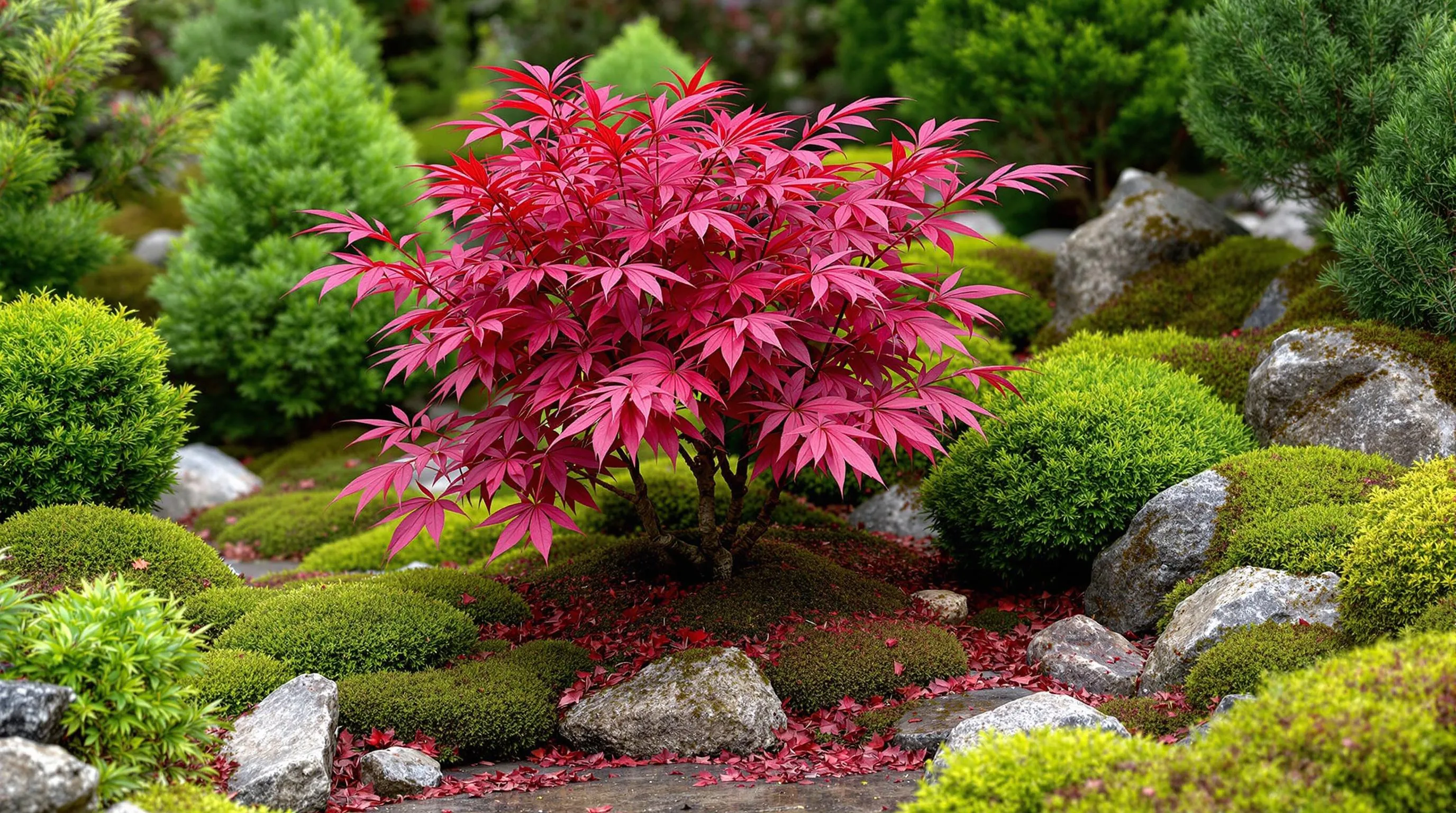
Selecting the right plants for your small Japanese garden is crucial for creating an authentic look while respecting spatial limitations. The best Japanese garden plants for compact spaces combine visual impact with manageable growth habits.
Dwarf Japanese Maples for Year-Round Color
Dwarf Japanese maples (Acer palmatum) are perfect centerpieces for small Japanese gardens, typically growing only 4-6 feet tall over many years. These compact trees provide stunning seasonal transformations with vibrant spring emergence, rich summer foliage, and spectacular fall colors ranging from golden yellow to deep crimson. Popular varieties include ‘Shaina’ with its bright red leaves, ‘Mikawa Yatsubusa’ offering dense, layered foliage, and ‘Sharp’s Pygmy’ known for its miniature stature. Plant your dwarf maple in a partially shaded location to protect delicate leaves from scorching and ensure it becomes a four-season focal point in your tiny garden.
Miniature Evergreens and Slow-Growing Conifers
Miniature evergreens and slow-growing conifers create the backbone of small Japanese gardens, providing structure and year-round interest while requiring minimal pruning. Dwarf Hinoki cypress (Chamaecyparis obtusa ‘Nana Gracilis’) grows merely 1-2 inches annually and develops a naturally sculptural form. Japanese garden juniper (Juniperus procumbens ‘Nana’) offers a sprawling, ground-covering texture that mimics mountainous landscapes. Mugo pine cultivars like ‘Pumilio’ maintain compact forms, reaching only 3-5 feet after decades of growth. These miniature conifers effectively create the illusion of mature trees in a fraction of the space, allowing you to establish a sense of age and permanence in your small garden.
Low-Maintenance Moss Gardens
Moss gardens offer an elegant, low-profile solution for small Japanese spaces, creating lush carpets that thrive in shady, humid environments with minimal care requirements. Common moss varieties like cushion moss (Leucobryum glaucum) and sheet moss (Hypnum) naturally spread to create seamless green tapestries that soften garden edges and fill gaps between stones. These moisture-loving plants eliminate the need for mowing or frequent watering once established, requiring only occasional weeding and gentle rinsing during dry periods. For fastest results, transplant moss patches from similar growing conditions or purchase preserved moss sheets that can be cut to fit your garden’s unique contours, creating an instant sense of age and serenity in your compact Japanese garden.
Designing with Traditional Japanese Garden Elements
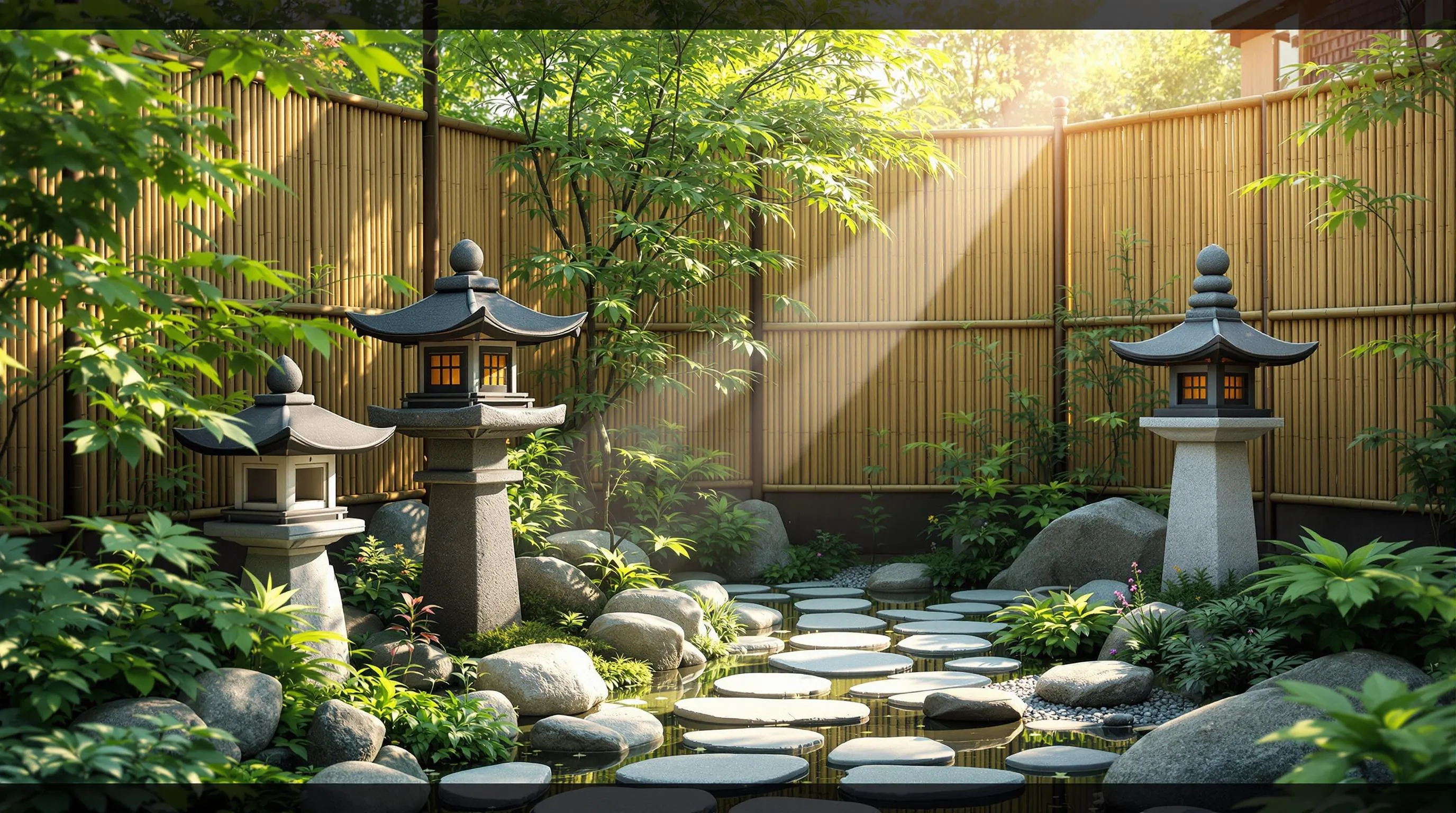
Traditional Japanese garden elements add authenticity and visual interest to your small space. These carefully selected features can transform even the tiniest area into a genuine Japanese garden experience.
Lanterns and Pagodas for Small Gardens
Stone lanterns (ishidōrō) serve as perfect focal points in small Japanese gardens, combining aesthetic appeal with cultural significance. Choose miniature versions—standing just 12-18 inches tall—to maintain proper scale in limited spaces. Place your lantern strategically near a turn in the path or beside water features for maximum impact. Small ceramic pagodas offer another space-conscious alternative, representing sacred mountains while requiring minimal room. For ultra-compact gardens, consider hanging lanterns that attach to walls or fences, eliminating the need for valuable ground space. These traditional elements not only enhance your garden’s authenticity during daylight hours but also create magical lighting effects at dusk when fitted with small LED lights.
Bamboo Fencing and Screens for Privacy
Bamboo elements create instant privacy while reinforcing your garden’s Japanese aesthetic. Install rolled bamboo fencing (gakubuchi) along property lines to define boundaries without consuming precious space—the vertical emphasis actually makes small areas feel larger. For ultimate space efficiency, opt for bamboo screens (sudare) that can be mounted on existing walls or fences. These screens come in various heights and create dappled light patterns that mimic forest canopies. Incorporate bamboo dividers within your garden to create distinct zones that make the space feel more expansive through separation. The natural honey tones of aged bamboo complement other garden elements while providing crucial structure. For added versatility, choose collapsible or rollable options that can be adjusted seasonally to control sunlight and privacy levels.
Tsubo-niwa: Courtyard Garden Ideas for Urban Homes
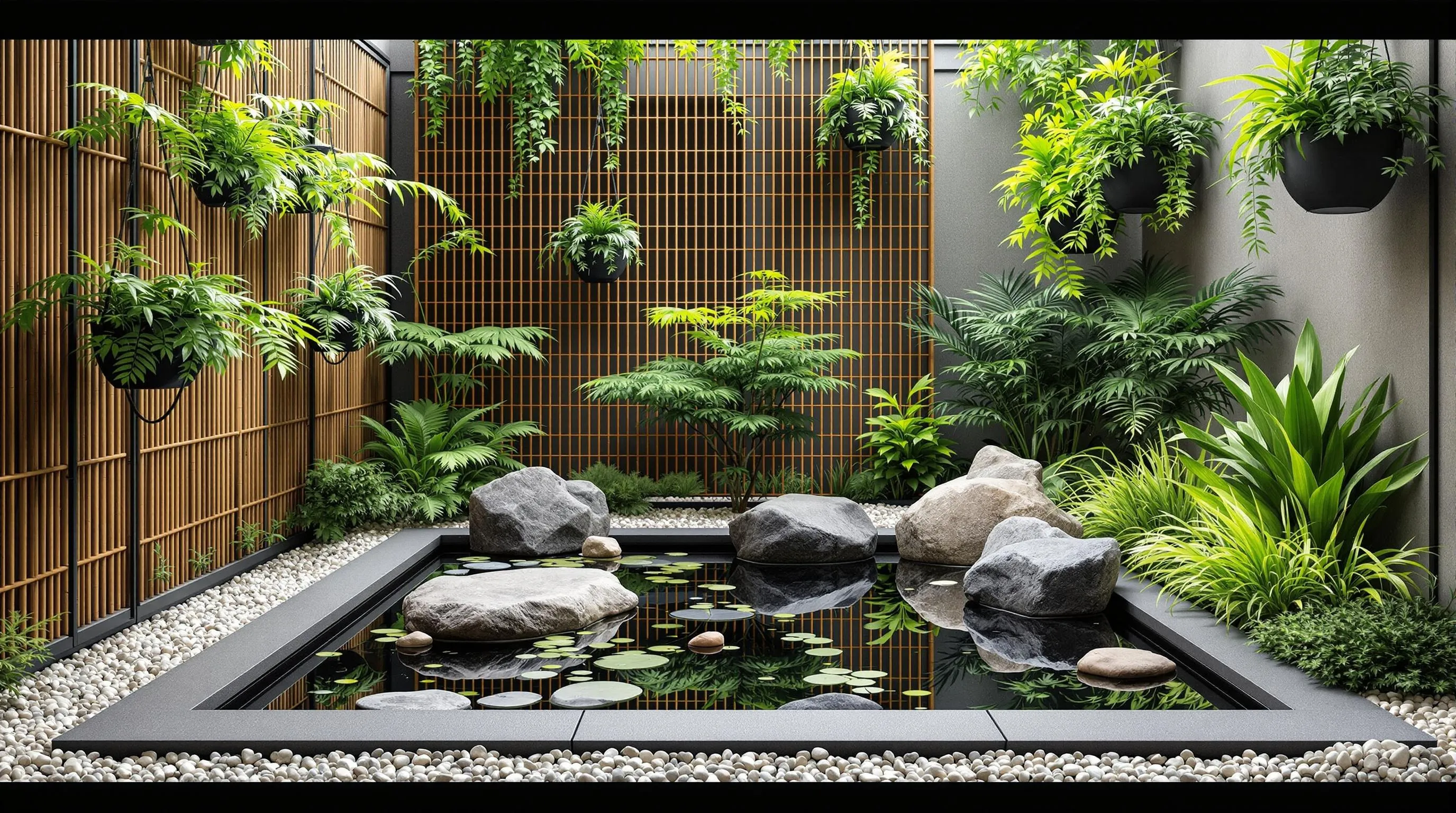
Tsubo-niwa gardens originated in Japan as small courtyard spaces designed to bring nature into densely populated urban homes. These pocket-sized gardens maximize limited space while creating a seamless connection between indoor and outdoor living. You’ll find these traditional courtyard designs perfect for modern apartments, condos, and townhouses where outdoor space comes at a premium.
Corner Garden Designs for Apartment Dwellers
Transform unused corners of your balcony or patio into miniature Japanese havens with strategic corner garden designs. Start by placing a compact water feature like a small ceramic basin against one wall, then arrange 2-3 different-sized rocks asymmetrically around it. Add a dwarf Japanese maple or compact azalea as your cornerstone plant, creating height without overwhelming the space. Line the edges with low-growing sedges or mondo grass to soften boundaries. For apartment dwellers with extremely limited floor space, consider hanging planters with cascading moss or ferns to create vertical interest without sacrificing precious square footage. Remember to maintain clean lines and avoid overcrowding—in tsubo-niwa design, negative space is as important as the elements themselves.
Utilizing Vertical Space with Wall-Mounted Features
Maximize your small courtyard garden by thinking upward with vertical garden elements. Install bamboo wall panels as a backdrop, then mount shallow planters containing trailing Japanese forest grass or miniature ferns. Wall-mounted stone basins or compact tsukubai fountains require minimal space while adding authentic water elements to your design. Consider adding small wall-mounted shelves for displaying miniature bonsai or moss arrangements at different heights, creating visual depth in confined spaces. Hanging lanterns from above not only provides ambient lighting but draws the eye upward, making your tsubo-niwa feel more expansive. For truly tiny spaces, a simple wall-mounted bamboo water spout (kakei) flowing into a stone basin creates tranquil sounds while occupying just a few inches of floor space. These vertical features effectively double your garden’s visual impact without expanding its footprint.
Container Japanese Gardens for Patios and Balconies
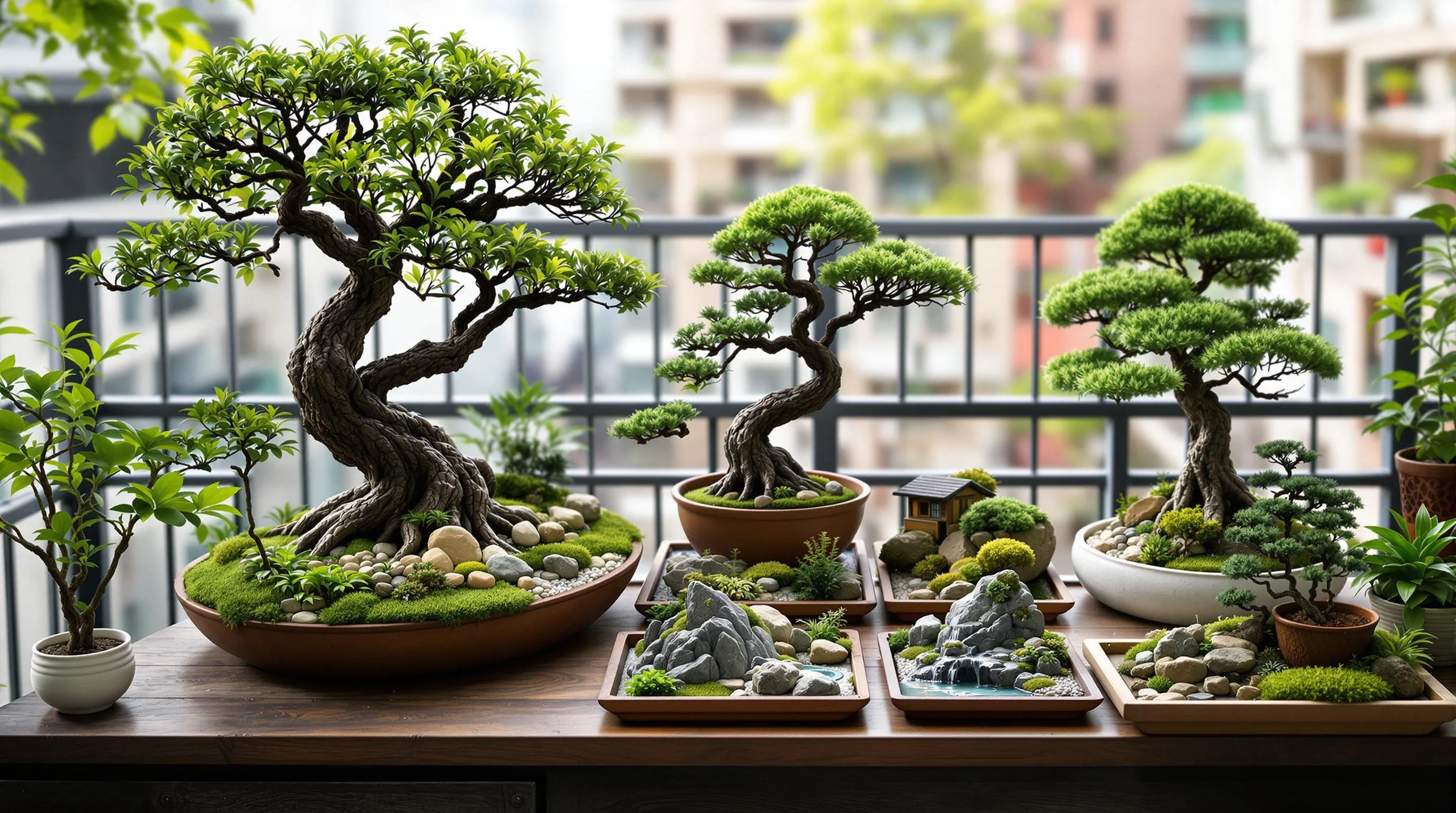
Container gardens offer the perfect solution for creating Japanese-inspired spaces on patios, balconies, and other small outdoor areas. These portable mini gardens capture the essence of traditional Japanese landscaping while requiring minimal space and allowing for flexible arrangements.
Bonsai Arrangements for Tabletop Gardens
Bonsai trees represent the ultimate expression of Japanese gardening in miniature form, making them perfect centerpieces for tabletop gardens. Choose hardy varieties like juniper, pine, or Japanese maple that can withstand outdoor conditions on your patio or balcony. Arrange your bonsai in shallow ceramic containers with complementary elements such as small rocks, moss patches, and miniature ornaments to create a complete industry. For maximum visual impact, group bonsai of different heights and textures together, creating a natural rhythm that draws the eye. Remember that bonsai require regular pruning, watering, and occasional repotting, but this maintenance becomes part of the meditative practice central to Japanese garden philosophy.
Miniature Landscapes in Shallow Trays
Shallow ceramic or stone trays provide the perfect foundation for creating detailed miniature Japanese landscapes. Select containers at least 2-3 inches deep with drainage holes and fill them with well-draining bonsai soil. Incorporate tiny elements like dwarf plants, small stones, miniature bridges, and fine gravel to represent mountains, forests, and rivers in scaled-down form. Position these trays near seating areas where their intricate details can be appreciated up close. The beauty of these compact landscapes lies in their ability to tell a complete story in minimal space—a meandering path might lead to a tiny stone lantern, while carefully placed moss suggests ancient forests. These tray gardens deliver the full Japanese garden experience without requiring more than a small corner of your balcony or patio.
Japanese-Inspired Pathway Solutions for Small Areas
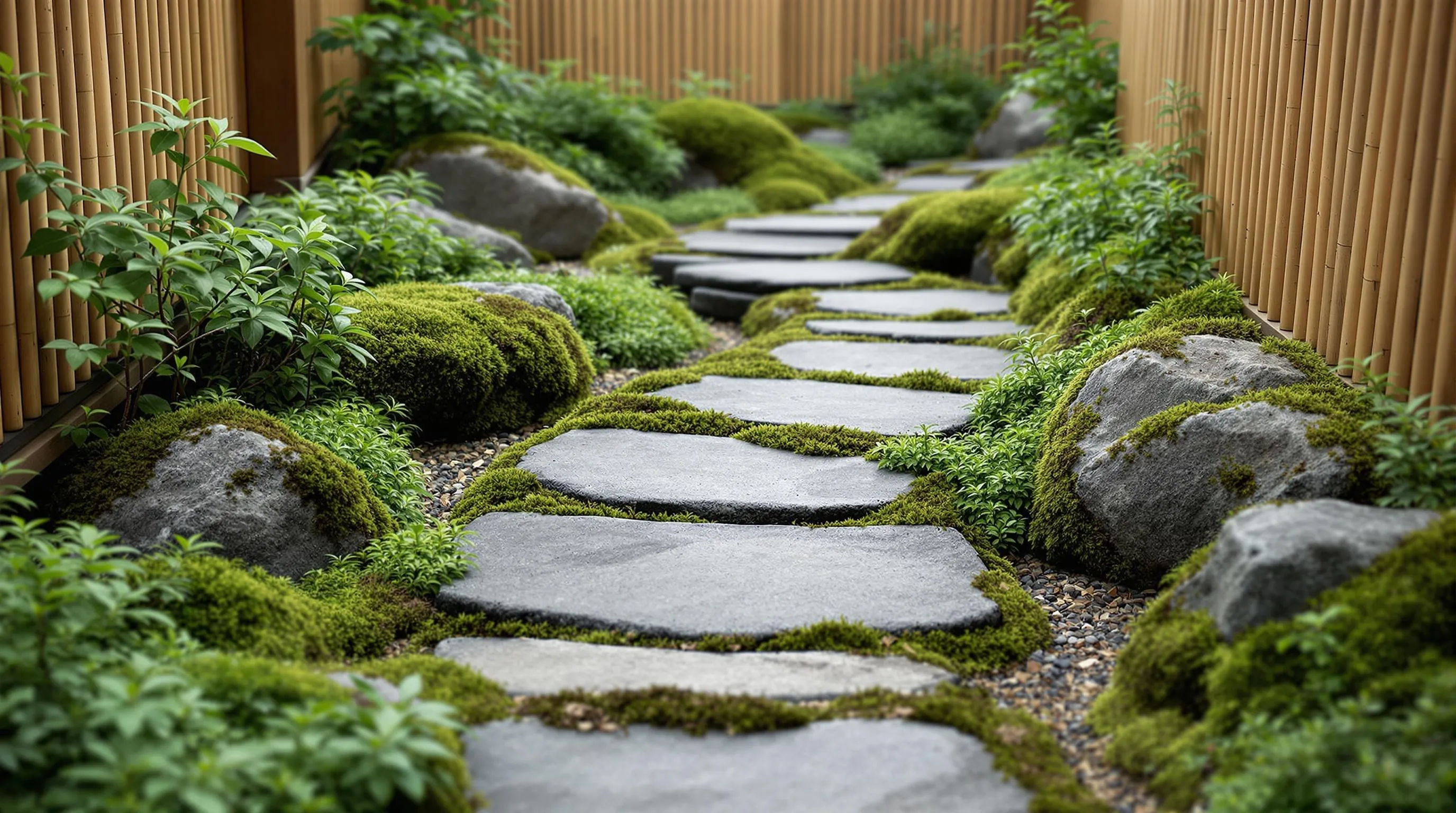
Pathways serve as both functional and aesthetic elements in Japanese gardens, guiding visitors through the space while creating visual flow. Even in the smallest gardens, well-designed paths can enhance the overall experience and make limited areas feel more expansive.
Stepping Stone Arrangements
Stepping stones (tobi-ishi) create natural pathways that maximize small garden space while adding authentic Japanese character. Select flat, weathered stones in varying shapes and sizes, placing them at comfortable walking distances (16-20 inches apart) in an asymmetrical pattern. For tiny gardens, use smaller stones set closer together, creating a winding path that suggests a longer journey. Integrate moss or creeping thyme between stones to soften edges and enhance the established feel. Position stones so they appear to float on beds of fine gravel or groundcover, creating visual interest without overwhelming the space. This arrangement not only serves as a functional walkway but also slows visitors down, encouraging mindful enjoyment of your compact garden.
Natural Material Walkways
Incorporate minimalist walkways using natural materials like bamboo slats, cedar planks, or river stones to create distinct paths in your small Japanese garden. These walkways establish clear movement patterns while preserving the garden’s serene atmosphere. For extremely tight spaces, consider a “suggestion” of a path using a thin line of pebbles or a narrow bamboo edging that guides the eye without requiring actual walking space. Elevate wooden walkways slightly above ground level to create depth and dimension in flat areas. This technique creates visual layers that make your garden appear larger while protecting delicate plants. For a contemporary twist, alternate materials like wood and stone in rhythmic patterns that maintain Japanese design principles while fitting perfectly in limited urban environments.
Maintaining Balance and Harmony in Limited Garden Spaces
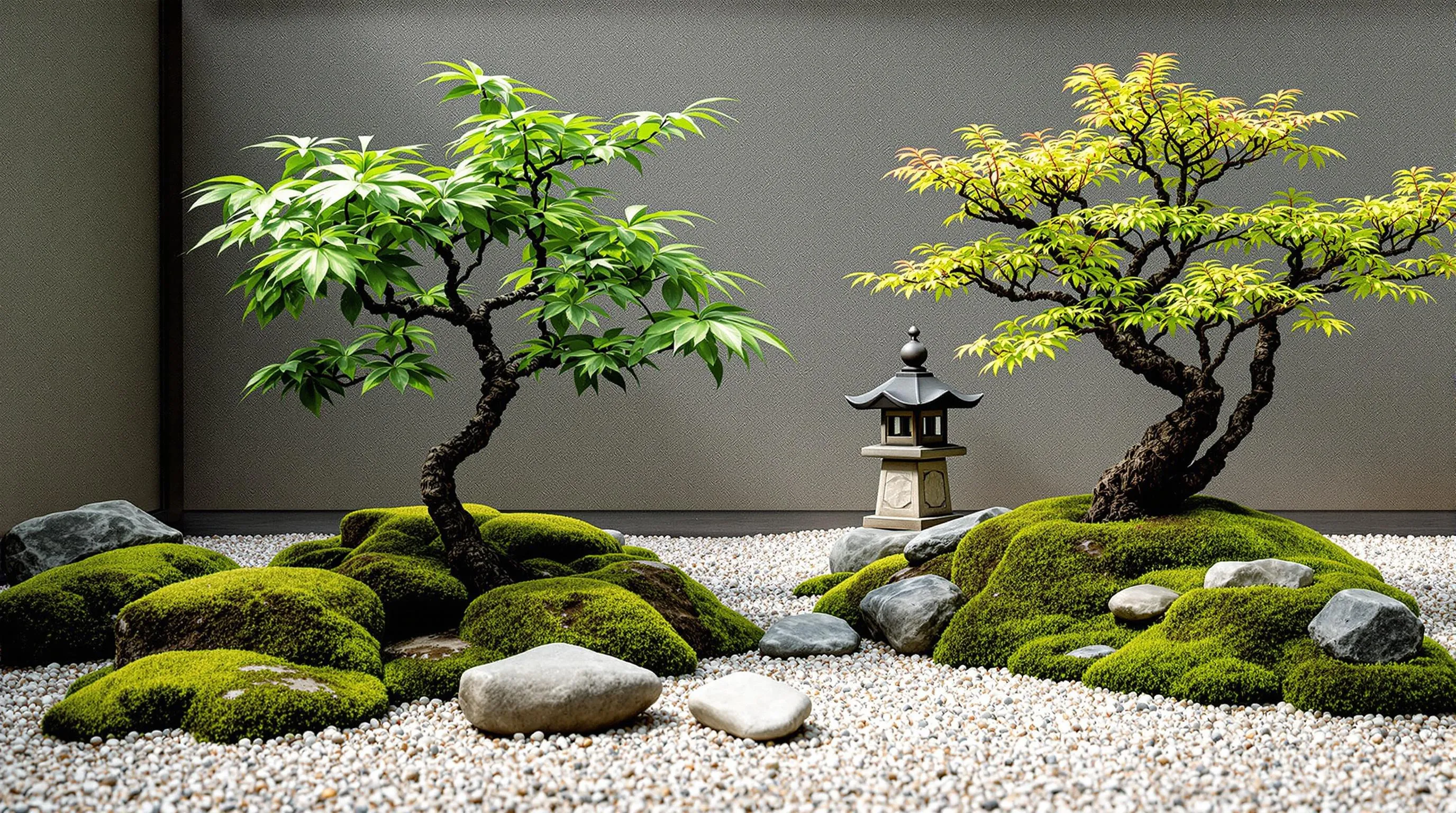
Creating harmony in small Japanese gardens requires thoughtful design that respects proportions and balances elements effectively. When working with limited space, each component must serve a purpose while contributing to the overall tranquility of your garden.
Incorporating Ma (Negative Space) in Small Designs
Ma, the Japanese concept of negative space, is essential for small gardens where clutter can quickly overwhelm. In limited areas, leave 30-40% of your space intentionally empty to create breathing room between elements. Position just 3-5 key features—like a single stone lantern, a dwarf maple, and a water basin—with ample space between them. This deliberate spacing allows each element to be appreciated fully rather than competing for attention. Use fine gravel or moss as neutral backgrounds that enhance the beauty of your focal points. Remember, in Japanese design philosophy, emptiness isn’t absence but rather a powerful design element that allows your garden to feel more spacious and contemplative than its actual dimensions suggest.
Seasonal Considerations for Tiny Japanese Gardens
Design your small Japanese garden to showcase seasonal transitions for year-round interest. Select plants that offer multiple seasons of beauty, such as Japanese maples with spring emergence, summer fullness, dramatic fall color, and winter branch architecture. Incorporate at least one evergreen element like a compact pine or nandina to maintain structure during winter months. For spring, include miniature flowering trees like dwarf cherry or plum varieties that won’t overwhelm your space. Consider adding a small ceramic vessel that can hold seasonal arrangements—winter branches, spring blossoms, or fall leaves—allowing you to celebrate seasonal changes even in the smallest garden. These thoughtful seasonal transitions create a ever-changing garden that feels fresh and captivating throughout the year while maintaining the peaceful atmosphere central to Japanese garden design.
Budget-Friendly DIY Japanese Garden Projects
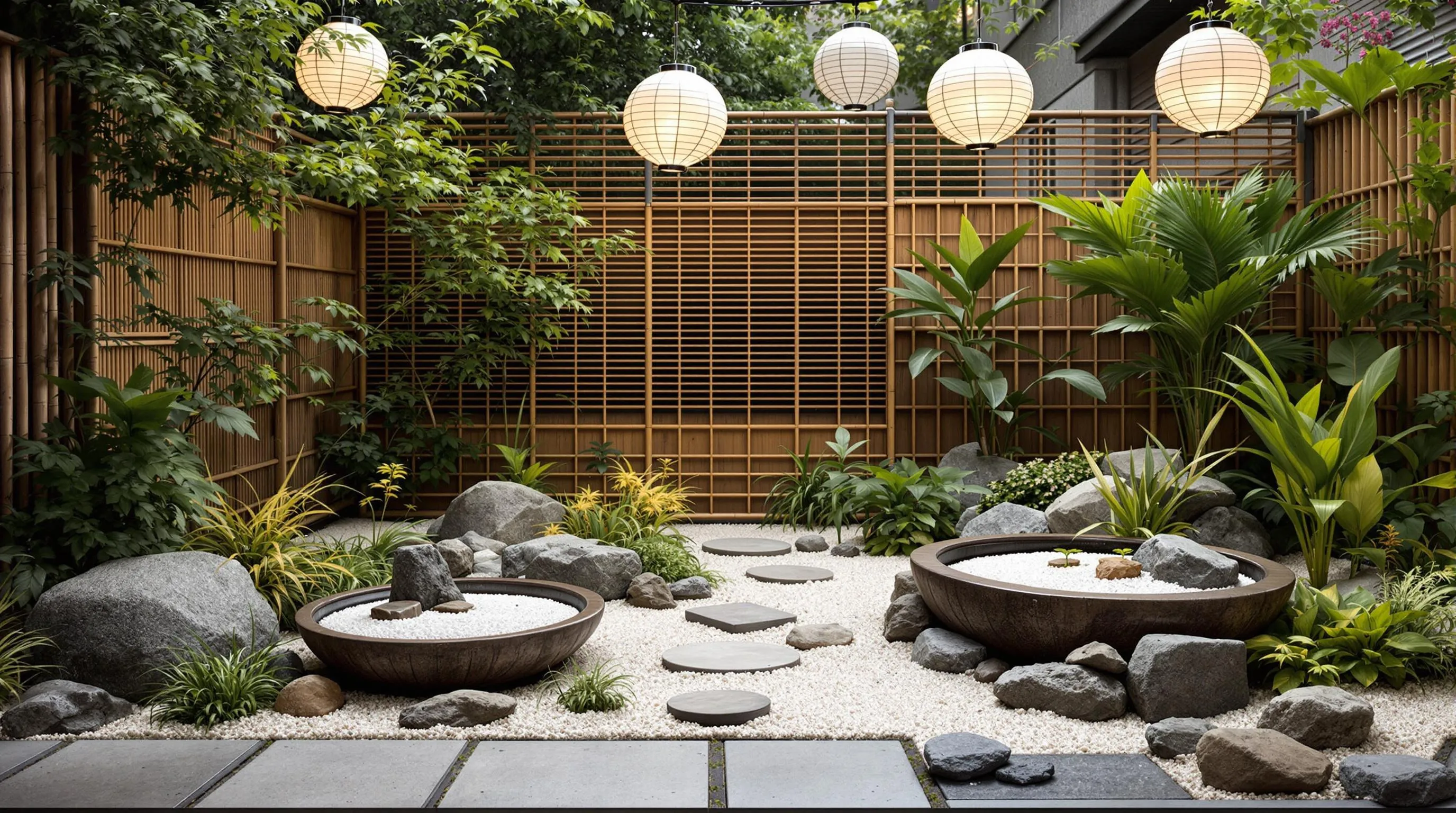
Creating a Japanese garden doesn’t have to drain your wallet. With some creativity and simple materials, you can create authentic Japanese garden features at a fraction of retail costs.
Repurposed Materials for Authentic Elements
Transform everyday items into stunning Japanese garden features with minimal investment. Old ceramic bowls can become perfect mini water basins—simply seal them for outdoor use and add a small pump ($15-20) for gentle water sounds. Salvaged concrete pavers make excellent stepping stones when arranged in an asymmetrical pattern; brush them with moss-encouraging yogurt mixture to accelerate aging. Repurpose bamboo kitchen utensils or old bamboo blinds to create authentic-looking fences and screens that add instant Japanese character. Even discarded granite countertop remnants (often free from stonemasters’ scrap piles) can be transformed into striking garden accents or miniature “mountains” for your industry, saving hundreds compared to purchased stone features.
Weekend Projects for Instant Japanese Garden Ambiance
Create impressive Japanese garden elements in just a weekend with these simple DIY projects. Build a tabletop zen garden using a shallow wooden box, fine white gravel ($5-10 per bag), and interesting stones collected during nature walks. Construct a shishi-odoshi (deer scarer) using bamboo pieces, plastic tubing, and a small recirculating pump for an authentic water feature that costs under $30. Fashion miniature torii gates from copper pipes or painted wooden dowels to establish sacred-feeling entrances to garden sections. For evening ambiance, make paper lanterns using outdoor-grade rice paper and LED tea lights, or upcycle glass jars with wire handles to create hanging lanterns that cast gentle, meditative light throughout your space. These quick projects deliver authentic Japanese garden elements without the premium price tags of store-bought versions.
Creating a Small Japanese Garden for Meditation and Relaxation
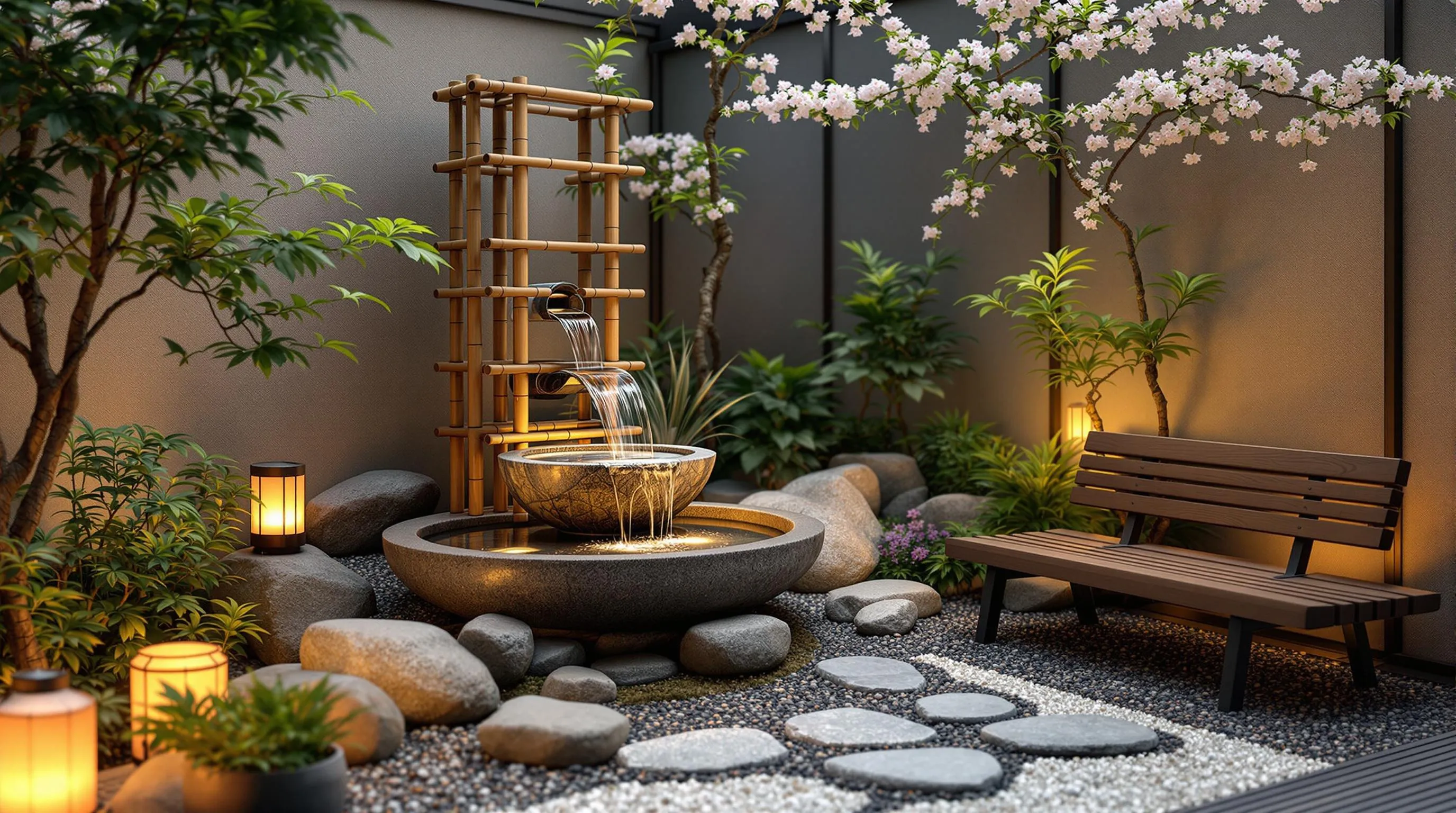
A small Japanese garden designed specifically for meditation can transform even the tiniest outdoor space into a personal sanctuary. Position your meditation spot facing a simple focal point like a small Buddha statue or a carefully placed rock arrangement to create a visual anchor for contemplation. Layer your garden with elements that engage multiple senses—incorporate the gentle sound of water from a compact bamboo fountain, plant fragrant Japanese jasmine nearby, and arrange smooth stones that feel pleasant to touch. Create a dedicated seating area using a small zabuton cushion or a simple wooden bench placed on a flat surface. Consider adding a tiny tea ceremony space with just enough room for a portable brazier and tea set if space allows. Keep the area clutter-free by limiting decorative elements to only those with meaningful purpose, following the principle that less is truly more in meditative spaces. Add soft lighting with paper lanterns or LED candles to extend your meditation practice into evening hours. Remember that the maintenance of your meditation garden—raking gravel patterns or pruning miniature trees—can become a mindful practice in itself, further improving the therapeutic benefits of your Japanese-inspired retreat.
Conclusion: Finding Tranquility in Your Small Japanese Garden
Your small Japanese garden isn’t limited by size but defined by intention. With thoughtful planning you can create a peaceful retreat that honors centuries-old traditions while fitting perfectly into your modern space. Whether you choose a zen rock garden container arrangement or courtyard design the principles of harmony balance and simplicity will guide your creation.
Remember that authentic Japanese gardens evolve over time becoming more beautiful with age. Start small focus on quality over quantity and allow your garden to become a living meditation on the beauty of nature in miniature form.
The true magic of your small Japanese garden lies not in its dimensions but in how it transforms your daily experience bringing moments of calm reflection and connection with nature right to your doorstep.

